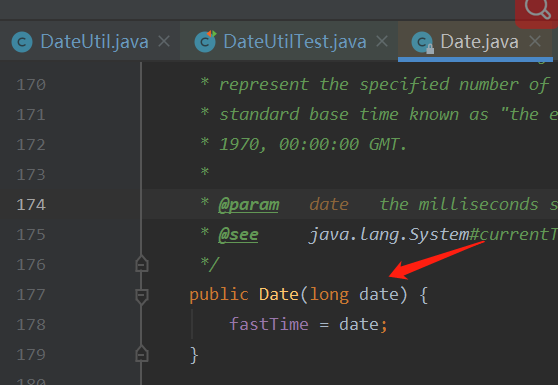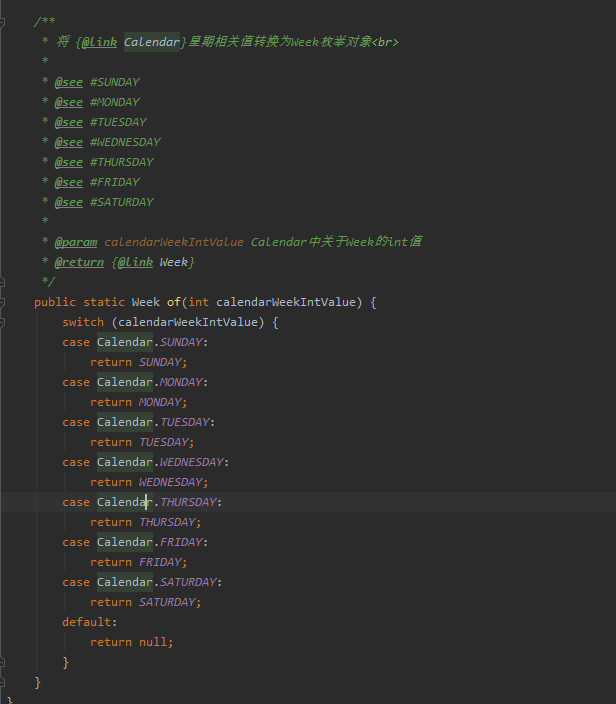技术活,该赏
关注+一键三连(点赞,评论,收藏)再看,养成好习惯
源码分析目的
知其然,知其所以然
项目引用
此博文的依据:hutool-5.6.5版本源码
<dependency>
<groupId>cn.hutool</groupId>
<artifactId>hutool-core</artifactId>
<version>5.6.5</version>
</dependency>
方法名称:DateUtil.date(java.util.Date)
方法描述
{@link Date}类型时间转为{@link DateTime}<br>
如果date本身为DateTime对象,则返回强转后的对象,否则新建一个DateTime对象
源码分析一
/**
* {@link Date}类型时间转为{@link DateTime}<br>
* 如果date本身为DateTime对象,则返回强转后的对象,否则新建一个DateTime对象
*
* @param date Long类型Date(Unix时间戳)
* @return 时间对象
* @since 3.0.7
*/
public static DateTime date(Date date) {
if (date instanceof DateTime) {
return (DateTime) date;
}
return dateNew(date);
}
判断传入的date是否是DateTime类型,如果是,直接转换成DateTime对象
如果不是,则执行DateUtil.dateNew((date)
方法名称:DateUtil.DateUtil.dateNew(java.util.Date)
方法描述
根据已有{@link Date} 产生新的{@link DateTime}对象
源码分析一
/**
* 根据已有{@link Date} 产生新的{@link DateTime}对象
*
* @param date Date对象
* @return {@link DateTime}对象
* @since 4.3.1
*/
public static DateTime dateNew(Date date) {
return new DateTime(date);
}
---------------------------------
//DateTime 类
/**
* 给定日期的构造
*
* @param date 日期
*/
public DateTime(Date date) {
this(
date,//
(date instanceof DateTime) ? ((DateTime) date).timeZone : TimeZone.getDefault()
);
}
代码里写了一个多目运算,(date instanceof DateTime) ? ((DateTime) date).timeZone : TimeZone.getDefault()。
传入的date是否是DateTime类型,如果是,直接取DateTime对象的时区,如果不是,取系统默认时区。
然后调用这个方法DateTime(Date date, TimeZone timeZone)
//DateTime 类
/**
* 给定日期的构造
*
* @param date 日期
* @param timeZone 时区
* @since 4.1.2
*/
public DateTime(Date date, TimeZone timeZone) {
this(ObjectUtil.defaultIfNull(date, new Date()).getTime(), timeZone);
}
ObjectUtil.defaultIfNull(date, new Date()).getTime()
要拆成2个调用
1、ObjectUtil.defaultIfNull(date, new Date())
2、Date.getTime()
ObjectUtil.defaultIfNull是Hutool封装的一个工具类,用来判断数据对象是否为null,如果是,返回默认值
源码如下
/**
* 如果给定对象为{@code null}返回默认值
*
* <pre>
* ObjectUtil.defaultIfNull(null, null) = null
* ObjectUtil.defaultIfNull(null, "") = ""
* ObjectUtil.defaultIfNull(null, "zz") = "zz"
* ObjectUtil.defaultIfNull("abc", *) = "abc"
* ObjectUtil.defaultIfNull(Boolean.TRUE, *) = Boolean.TRUE
* </pre>
*
* @param <T> 对象类型
* @param object 被检查对象,可能为{@code null}
* @param defaultValue 被检查对象为{@code null}返回的默认值,可以为{@code null}
* @return 被检查对象为{@code null}返回默认值,否则返回原值
* @since 3.0.7
*/
public static <T> T defaultIfNull(final T object, final T defaultValue) {
return (null != object) ? object : defaultValue;
}
最后会调用这个方法
/**
* 给定日期毫秒数的构造
*
* @param timeMillis 日期毫秒数
* @param timeZone 时区
* @since 4.1.2
*/
public DateTime(long timeMillis, TimeZone timeZone) {
super(timeMillis);
this.timeZone = ObjectUtil.defaultIfNull(timeZone, TimeZone.getDefault());
}
从**DateTime(long timeMillis, TimeZone timeZone)中源码中,可看出,在Date(long date)**基础上,多加了timeZone的赋值。
方法名称:DateUtil.DateUtil.date(long)
方法描述
Long类型时间转为{@link DateTime}<br>
只支持毫秒级别时间戳,如果需要秒级别时间戳,请自行×1000
源码分析一
/**
* Long类型时间转为{@link DateTime}<br>
* 只支持毫秒级别时间戳,如果需要秒级别时间戳,请自行×1000
*
* @param date Long类型Date(Unix时间戳)
* @return 时间对象
*/
public static DateTime date(long date) {
return new DateTime(date);
}
-------------------------------------
/**
* 给定日期毫秒数的构造
*
* @param timeMillis 日期毫秒数
* @since 4.1.2
*/
public DateTime(long timeMillis) {
this(timeMillis, TimeZone.getDefault());
}
从**DateTime(long timeMillis, TimeZone timeZone)中源码中,可看出,在Date(long date)**基础上,多加了timeZone的赋值。
方法名称:DateUtil.DateUtil.date(java.util.Calendar)
方法描述
{@link Calendar}类型时间转为{@link DateTime}<br>
始终根据已有{@link Calendar} 产生新的{@link DateTime}对象
源码分析一
/**
* {@link Calendar}类型时间转为{@link DateTime}<br>
* 始终根据已有{@link Calendar} 产生新的{@link DateTime}对象
*
* @param calendar {@link Calendar}
* @return 时间对象
*/
public static DateTime date(Calendar calendar) {
return new DateTime(calendar);
}
----------------------------
//DateTime类
/**
* 给定日期的构造
*
* @param calendar {@link Calendar}
*/
public DateTime(Calendar calendar) {
this(calendar.getTime(), calendar.getTimeZone());
this.setFirstDayOfWeek(Week.of(calendar.getFirstDayOfWeek()));
}
**this(calendar.getTime(), calendar.getTimeZone());**就是调用 DateTime(Date date, TimeZone timeZone)
this.setFirstDayOfWeek(Week.of(calendar.getFirstDayOfWeek()));
实际上是调用了三个步骤:
1、calendar.getFirstDayOfWeek() 获取calendarWeekIntValue(一周的第一天)
2、Week.of(calendar.getFirstDayOfWeek()) -->Week of(int calendarWeekIntValue) 获取星期对应的枚举值
3、this.setFirstDayOfWeek(Week.of(calendar.getFirstDayOfWeek())) -->setFirstDayOfWeek(Week firstDayOfWeek) 给DateTime对象设置一周的第一天参数的值。
/**
* 设置一周的第一天<br>
* JDK的Calendar中默认一周的第一天是周日,Hutool中将此默认值设置为周一<br>
* 设置一周的第一天主要影响{@link #weekOfMonth()}和{@link #weekOfYear()} 两个方法
*
* @param firstDayOfWeek 一周的第一天
* @return this
* @see #weekOfMonth()
* @see #weekOfYear()
*/
public DateTime setFirstDayOfWeek(Week firstDayOfWeek) {
this.firstDayOfWeek = firstDayOfWeek;
return this;
}
方法名称:DateUtil.DateUtil.date(java.time.temporal.TemporalAccessor)
方法描述
{@link TemporalAccessor}类型时间转为{@link DateTime}<br>
始终根据已有{@link TemporalAccessor} 产生新的{@link DateTime}对象
源码分析一
/**
* {@link TemporalAccessor}类型时间转为{@link DateTime}<br>
* 始终根据已有{@link TemporalAccessor} 产生新的{@link DateTime}对象
*
* @param temporalAccessor {@link TemporalAccessor},常用子类: {@link LocalDateTime}、 LocalDate
* @return 时间对象
* @since 5.0.0
*/
public static DateTime date(TemporalAccessor temporalAccessor) {
return new DateTime(temporalAccessor);
}
----------------------------------------------
//DateTime 对象
/**
* 给定日期TemporalAccessor的构造
*
* @param temporalAccessor {@link TemporalAccessor} 对象
* @since 5.0.0
*/
public DateTime(TemporalAccessor temporalAccessor) {
this(DateUtil.toInstant(temporalAccessor));
}
**this(DateUtil.toInstant(temporalAccessor));**这里调用了两个步骤
1、DateUtil.toInstant(temporalAccessor) TemporalAccessor 对象转为Instant对象
2、this(DateUtil.toInstant(temporalAccessor)); —>DateTime(Instant instant)
/**
* 给定日期Instant的构造
*
* @param instant {@link Instant} 对象
* @since 5.0.0
*/
public DateTime(Instant instant) {
this(instant.toEpochMilli());
}
----------------------
/**
* 给定日期毫秒数的构造
*
* @param timeMillis 日期毫秒数
* @since 4.1.2
*/
public DateTime(long timeMillis) {
this(timeMillis, TimeZone.getDefault());
}
万变不离其宗,看,又绕回来了

